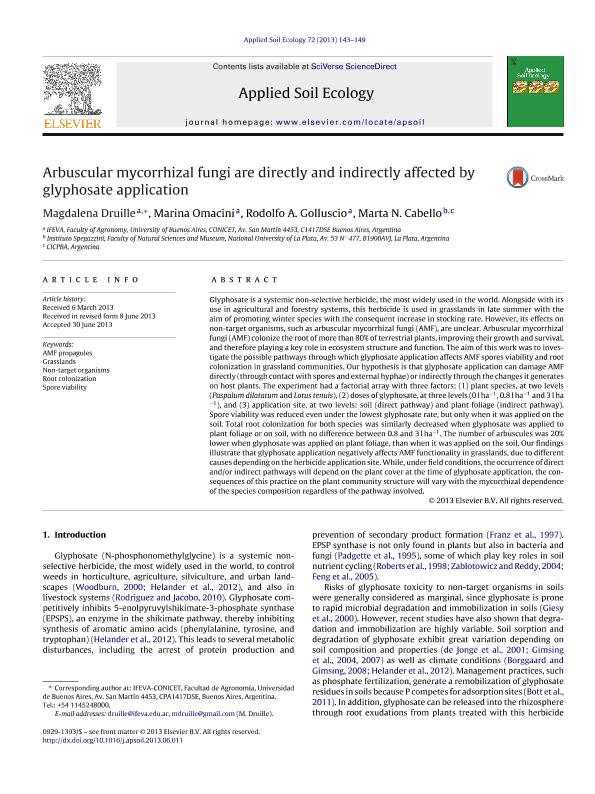Artículo
Arbuscular mycorrhizal fungi are directly and indirectly affected byglyphosate application
Fecha de publicación:
06/2013
Editorial:
Elsevier
Revista:
Applied Soil Ecology
ISSN:
0929-1393
Idioma:
Inglés
Tipo de recurso:
Artículo publicado
Clasificación temática:
Resumen
Glyphosate is a systemic non-selective herbicide, the most widely used in the world. Alongside with itsuse in agricultural and forestry systems, this herbicide is used in grasslands in late summer with theaim of promoting winter species with the consequent increase in stocking rate. However, its effects onnon-target organisms, such as arbuscular mycorrhizal fungi (AMF), are unclear. Arbuscular mycorrhizalfungi (AMF) colonize the root of more than 80% of terrestrial plants, improving their growth and survival,and therefore playing a key role in ecosystem structure and function. The aim of this work was to inves-tigate the possible pathways through which glyphosate application affects AMF spores viability and rootcolonization in grassland communities. Our hypothesis is that glyphosate application can damage AMFdirectly (through contact with spores and external hyphae) or indirectly through the changes it generateson host plants. The experiment had a factorial array with three factors: (1) plant species, at two levels(Paspalum dilatatum and Lotus tenuis), (2) doses of glyphosate, at three levels (0 l ha−1, 0.8 l ha−1and 3 l ha−1), and (3) application site, at two levels: soil (direct pathway) and plant foliage (indirect pathway).Spore viability was reduced even under the lowest glyphosate rate, but only when it was applied on thesoil. Total root colonization for both species was similarly decreased when glyphosate was applied toplant foliage or on soil, with no difference between 0.8 and 3 l ha−1. The number of arbuscules was 20%lower when glyphosate was applied on plant foliage, than when it was applied on the soil. Our findingsillustrate that glyphosate application negatively affects AMF functionality in grasslands, due to differentcauses depending on the herbicide application site. While, under field conditions, the occurrence of directand/or indirect pathways will depend on the plant cover at the time of glyphosate application, the con-sequences of this practice on the plant community structure will vary with the mycorrhizal dependenceof the species composition regardless of the pathway involved.
Palabras clave:
Amf Propagules
,
Grasslands
,
Non-Target Organisms
,
Root Colonization
Archivos asociados
Licencia
Identificadores
Colecciones
Articulos(IFEVA)
Articulos de INST.D/INV.FISIOLOGICAS Y ECO.VINCULADAS A L/AGRIC
Articulos de INST.D/INV.FISIOLOGICAS Y ECO.VINCULADAS A L/AGRIC
Citación
Druille, Magdalena; Omacini, Marina; Golluscio, Rodolfo; Cabello, Marta Noemi; Arbuscular mycorrhizal fungi are directly and indirectly affected byglyphosate application; Elsevier; Applied Soil Ecology; 72; 6-2013; 143-149
Compartir
Altmétricas




